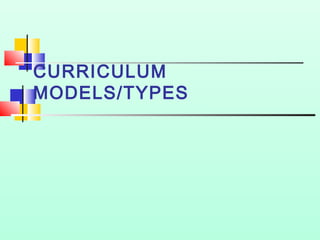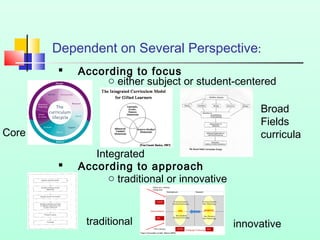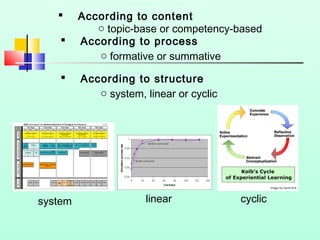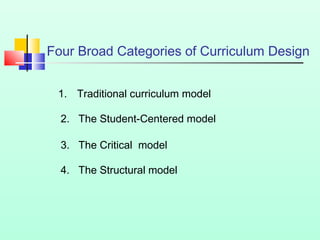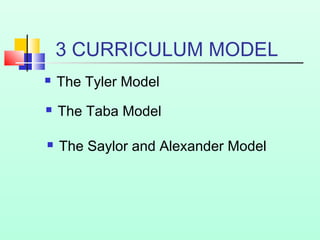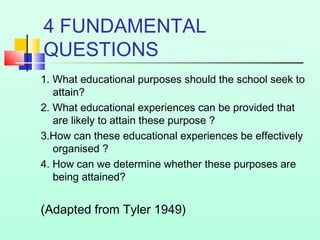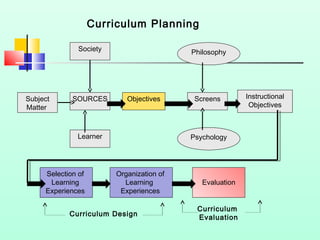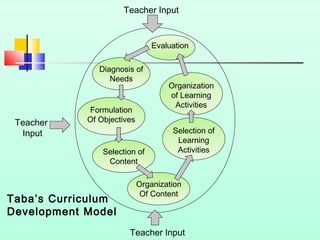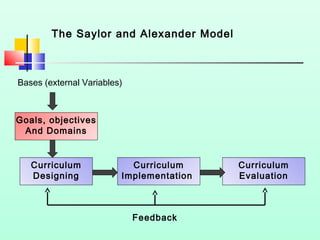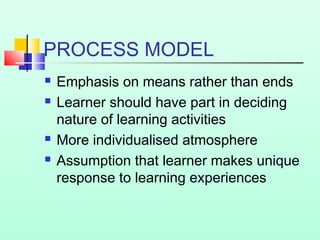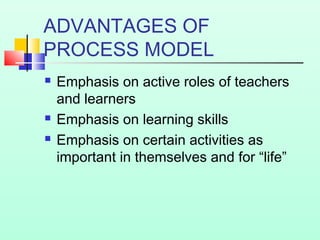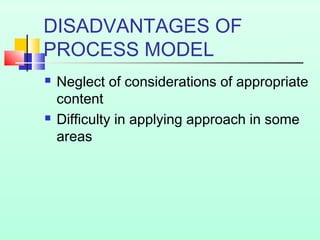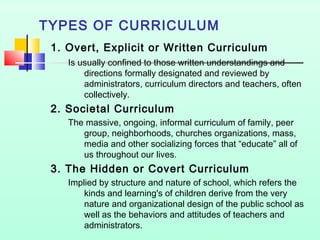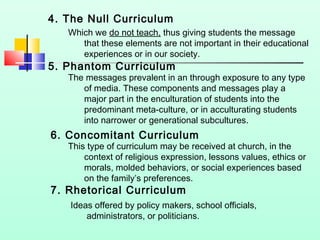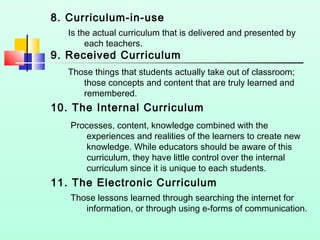Curriculum models and types
- 2. WHAT IS CURRICULUM MODELS? Madeus and Stafflebeam (1989) outline approaches methods procedures Teaching and learning and target the needs and characteristics of particular group of students. consist of interacting parts that serves as a guide or procedure
- 3. Dependent on Several Perspective: According to focus o either subject or student-centered Broad Fields curricula Core Integrated According to approach o traditional or innovative traditional innovative
- 4. system According to content o topic-base or competency-based According to process o formative or summative According to structure o system, linear or cyclic linear cyclic
- 5. Four Broad Categories of Curriculum Design 1. Traditional curriculum model 2. The Student-Centered model 3. The Critical model 4. The Structural model
- 6. 3 CURRICULUM MODEL The Tyler Model The Taba Model The Saylor and Alexander Model
- 7. 4 FUNDAMENTAL QUESTIONS 1. What educational purposes should the school seek to attain? 2. What educational experiences can be provided that are likely to attain these purpose ? 3.How can these educational experiences be effectively organised ? 4. How can we determine whether these purposes are being attained? (Adapted from Tyler 1949)
- 8. Curriculum Planning Society Subject Matter SOURCES Philosophy Objectives Learner Selection of Learning Experiences Screens Psychology Organization of Learning Experiences Curriculum Design Evaluation Curriculum Evaluation Instructional Objectives
- 9. Taba Models She believed that teachers who teach curriculum should practice or participate in developing curriculum. Which led to the model she called grass-roots approach. Taba proposed 7 major steps to her grass-roots model in which Teachers would have a major input throughout the curriculum development process. Taba said Tyler’s model was more of Administrative Model
- 10. Teacher Input Evaluation Diagnosis of Needs Teacher Input Formulation Of Objectives Selection of Content Taba’s Curriculum Development Model Organization of Learning Activities Selection of Learning Activities Organization Of Content Teacher Input
- 11. The Saylor and Alexander Model Bases (external Variables) Goals, objectives And Domains Curriculum Designing Curriculum Implementation Feedback Curriculum Evaluation
- 12. PROCESS MODEL Emphasis on means rather than ends Learner should have part in deciding nature of learning activities More individualised atmosphere Assumption that learner makes unique response to learning experiences
- 13. ADVANTAGES OF PROCESS MODEL Emphasis on active roles of teachers and learners Emphasis on learning skills Emphasis on certain activities as important in themselves and for “life”
- 14. DISADVANTAGES OF PROCESS MODEL Neglect of considerations of appropriate content Difficulty in applying approach in some areas
- 15. TYPES OF CURRICULUM 1. Overt, Explicit or Written Curriculum Is usually confined to those written understandings and directions formally designated and reviewed by administrators, curriculum directors and teachers, often collectively. 2. Societal Curriculum The massive, ongoing, informal curriculum of family, peer group, neighborhoods, churches organizations, mass, media and other socializing forces that “educate” all of us throughout our lives. 3. The Hidden or Covert Curriculum Implied by structure and nature of school, which refers the kinds and learning's of children derive from the very nature and organizational design of the public school as well as the behaviors and attitudes of teachers and administrators.
- 16. 4. The Null Curriculum Which we do not teach, thus giving students the message that these elements are not important in their educational experiences or in our society. 5. Phantom Curriculum The messages prevalent in an through exposure to any type of media. These components and messages play a major part in the enculturation of students into the predominant meta-culture, or in acculturating students into narrower or generational subcultures. 6. Concomitant Curriculum This type of curriculum may be received at church, in the context of religious expression, lessons values, ethics or morals, molded behaviors, or social experiences based on the family’s preferences. 7. Rhetorical Curriculum Ideas offered by policy makers, school officials, administrators, or politicians.
- 17. 8. Curriculum-in-use Is the actual curriculum that is delivered and presented by each teachers. 9. Received Curriculum Those things that students actually take out of classroom; those concepts and content that are truly learned and remembered. 10. The Internal Curriculum Processes, content, knowledge combined with the experiences and realities of the learners to create new knowledge. While educators should be aware of this curriculum, they have little control over the internal curriculum since it is unique to each students. 11. The Electronic Curriculum Those lessons learned through searching the internet for information, or through using e-forms of communication.

